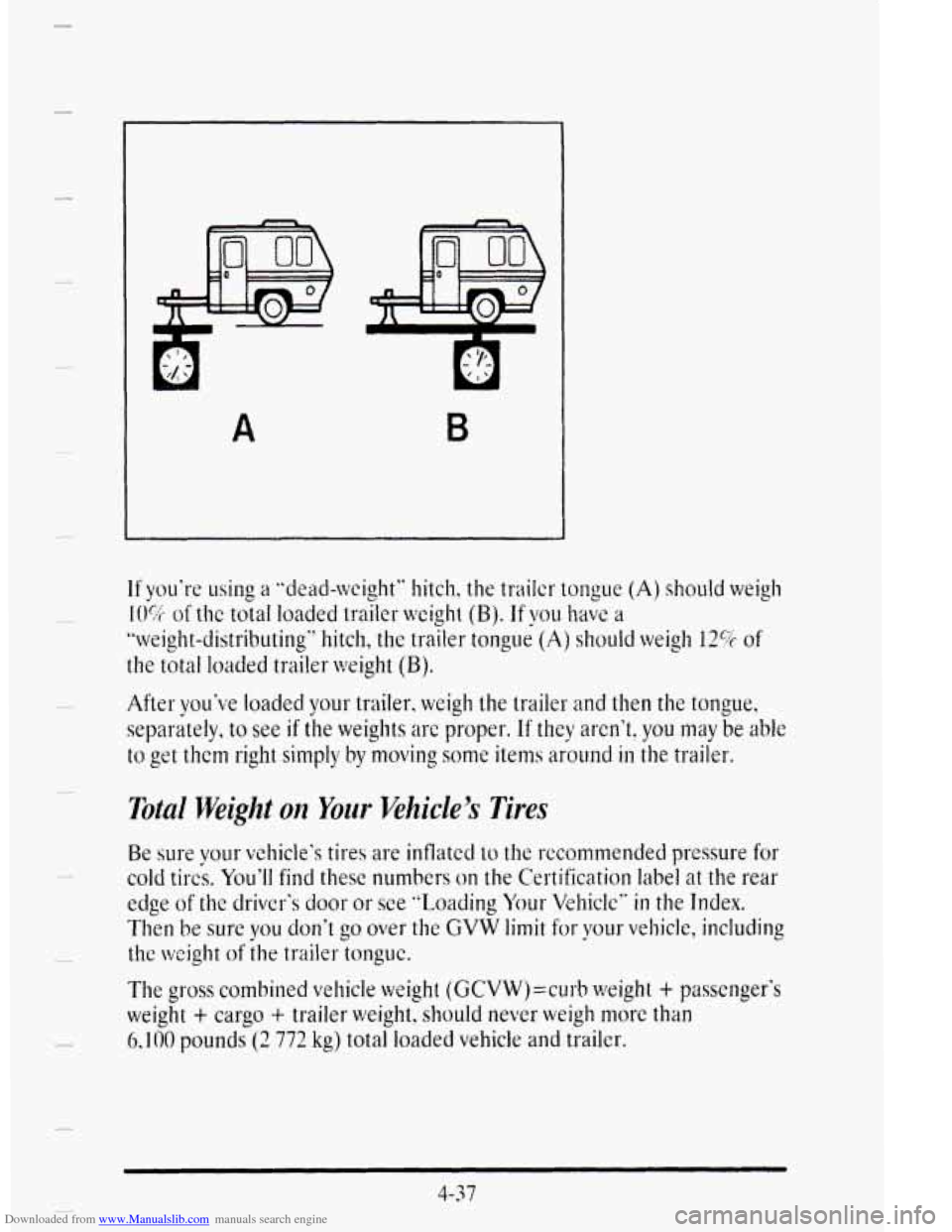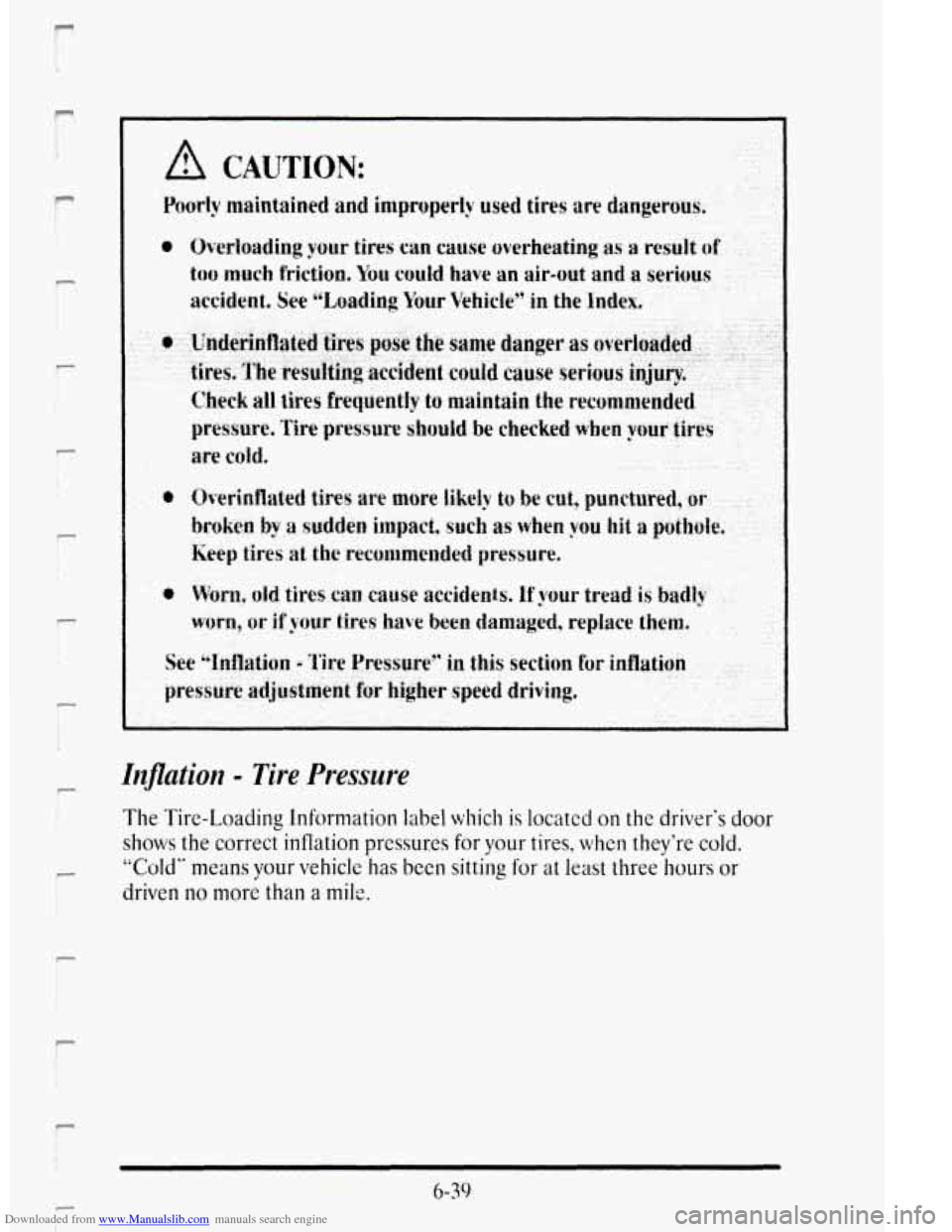1995 CADILLAC DEVILLE tire pressure
[x] Cancel search: tire pressurePage 201 of 403

Downloaded from www.Manualslib.com manuals search engine You slam on the brakes. Here's what happens with ABS.
A computer senses that wheels are slowing down. If one of the wheels is
about to stop rolling, the computer will separately work the brakes at each
front wheel
and at the rear wheels.
The anti-lock system can change the brake pressure faster than any driver
could. The computer
is programmed to make the most of available tire
and road conditions.
.. , ,.. .. . '.' - ... . ... .. *.
You can steer around the obstacle while braking hard.
As you brake, your computer keeps receiving updates
on wheel speed and
controls braking pressure accordingly.
Remember: Anti-lock doesn't change the time
you need to get your foot
up to the brake pedal. If you get too close to the vehicle in front of you,
you won't have time to apply your brakes if that vehicle suddenly slows or
stops. Always leave e.nough room up ahead to stop, even though you have
anti-lock brakes.
To Use Anti-Lock
Don't pump the brakes. Just hold the brake pedal down and fet anti-lock
work for
you. You may hear the anti-lock pump or motor operate, and
feel the brake pedal pulsate,
but this is normal.
4-8
Y
c
Page 213 of 403

Downloaded from www.Manualslib.com manuals search engine Hydrupluning
Hydroplaning is dangerous. So much water can build up under your tires
that they can actually ride
on the water. This can happen if the road is wet
enough and you’re going fast enough. When your vehicle
is hydroplaning,
it has little or no contact with the road.
Hydroplaning doesn’t happen often. But it can if your tires haven‘t much
tread or
if the pressure in one or more is low. It can happen if a lot of
water
is standing on the road. If you can see reflections from trees,
telephone poles,
or other vehicles, and raindrops ‘‘dimple’‘ the water‘s
surface, there could be hydroplaning.
Hydroplaning
usually happens at higher speeds. There just isn‘t a hard
and fast
rule about hydroplaning. The best advice is to slow down when it
is raining.
Some Other Rainy Weather Tips
0 Turn on your low beam headlamps -- not just your parking lamps -- to
help
make you more visible to others.
Besides slowing down, allow some extra following distance. And be
especially careful when you pass another vehicle. Allow yourself more
clear
room ahead, and be prepared to have your view restricted by
road spray.
Have good tires with proper tread depth. (See “Tires” in the Index.)
4-20
Page 216 of 403

Downloaded from www.Manualslib.com manuals search engine Once you are moving on the freeway, make certain you allow a reasonable
following distance. Expect
to move slightly slower at night.
When
you want to leave the freeway, move to the proper lane well in
advance. If vou miss your exit do not, under any circumstances, stop and
back
up. Dr& on tolthe ncst exit.
The exit
ramp can be cuwed, sometimes quite sharply.
The exit
speed is usually posted.
BEFORE LEAUNG ON A LONG TRIP
Make sure vou're ready. Try to be well rested. If vou must start when
you're not iresh -- such as aftcr a day's work -- d6n.t plan to make too
many miles that first part of the journey. Wear comfortable clothing and
shoes
you can easily driw in.
Is vour vehicle ready for a long trip'! If you keep it stlnliced and
miintained, it's ready
to go. If it needs service, have it done before
starting
out. Of course, you'll find experienced and able service experts in
Cadillac dealerships all across North America. They'll be ready and
willing
to help if you need it.
Here are some things you can check before a trip:
Wirdd1ield Woslter Fluid: Is the reservoir full'? Are all windows clean
inside
and outside?
Tires: They are vitally important to a safe, trouble-free trip, Is the tread
good enough for long-distancc driving? Are thc tires all inflated to the
recornnxnded pressure'?
Should you
delay your trip a short time to avoid a major storm system'?
Weather Fomusts: What's the weather outlook along your route?
Mcq~s: Do you have up-to-date maps?
4-23
Page 225 of 403

Downloaded from www.Manualslib.com manuals search engine Then, shut the engine off' and close the window almost all the way to
preserve the heat. Start the engine again and repeat this only when you
feel reallv u~~comfortable from the cold. But do it as little as possible.
Presewe'the fuel as long as you can. 'To help keep warm, vou can get out
of the vehicle and do some fairly vigorous exercises eve1i half hour or so
until hclp comes.
LOADING YOUR VEHICLE
TIRE-LOADING INFORMATION
OCCUPANTS
VEHICLE CAP. WT. I
INFORMATION
FRT. CTR. RR. TOTAL LBS. KG
MAX. LOADING & GVWR SAME AS VEHICLE
CAPACITY WEIGHT XXX COLD TIRE
TIRE SIZE SPEED PRESSURE
RTG PSVKPa
FRT.
RR.
SPA.
IF TIRES ARE HOT. ADD 4PSV28KPa SEE
OWNER'S MANUAL FOR ADDITIONAL
TLVO labels on your vehicle show how nwch wcight it may properly carry.
The Tire-Loading Information label found on the driver's door tells you
the proper size? speed rating and recommended inflation pressures for the
tires on your vehicle. It also gives you important information about the
number
of people that can be in your vehicle and the total weight that you
can carry. This weight is called the Vehicle Capacity Weight and includes
the weight of all occupants, cargo and all non-factory installed options.
4-32
Page 230 of 403

Downloaded from www.Manualslib.com manuals search engine A
If you’re using a “dead-weight” hitch, the trailcr tongue (A) should weigh
10% of thc total loaded trailer weight (B). If you have a
“weight-dist~-ibut.ing’? hitch, the trailer tongue (A) should weigh 12$+ of
the total loaded trailer weight (B).
After Vou‘ve loaded your trailer. weigh the trailer and then the tongue,
separately, to see if the weights arc proper. If they aren’t, you may be able
to get them right L, simply by moving sonx items around in the trailer.
Total Weight on Your Vehicle’s Tires
Be sure vow vehicle’s tires are infiatcd to the 1-ccomrnendec1 pressure for
cold tir& Yt~~’l1 find these numbers on the Certification label at the rear
edge of
the driver’s door or sce “Loading Your Vehicle” in the Index.
Then
be sure you don‘t go over the GVW limit for your vehicle, including
the
weight of the trailer tonguc.
The gross combined
vehicle weight (GCVW)=curb weight + passcnger’s
weight
+ cargo + trailer weight, should never weigh more than
6,300 pounds (2 772 kg) total loaded vehicle and trailer.
4-37
Page 308 of 403

Downloaded from www.Manualslib.com manuals search engine P
r
i
i
c
r
I
t
i
Inflution - Tire Pressure
The Tire-Loading Information label which is located on the driver's door
shows the correct inflation prcssutes for your tires, when they're cold.
"Cold" means your vehicle has been sitting for at least three hours or
driven
no more than a mile.
Page 398 of 403

Downloaded from www.Manualslib.com manuals search engine F I i i
r
P
Starting Disabled Message ........................... 2-90
Starting Your Engine ............................... 2-22
Steam. If Coming From Your Engine .................. 5-12
Steering .......................................... 4-10
Column Shift Lever .............................. 2-31
In Emergencies .................................. 4-12
Power .......................................... 4-10
Speed Sensitive .................................. 2-93
Tips ........................................... 4-11
Wheel. Tilts ..................................... 2-38
Stop Engine Engine Overheated Message .............. 2-91
Stop Engine Low Oil Pressure Message ................ 2-91
Storage. Of Your Vehicle ............................ 6-30
Stuck. If You Are ................................... 5-34
Supplemental Inflatable Restraint (SIR) ............... 1-21
Suspension. Speed Sensitive .......................... 2-93
Symbols. Vehicle ...................................... v
T
I
I
r L .
r
r
P t.
Taillamps. Bulb Replacement ......................... 6-35
Taillamps Monitor. Rear ............................. 2-56
Tape Player Care ................................... 3-23
Temperature ........................................ 3-3
Theft ............................................. 2-16
Theft Deterrent Alarm System ....................... 2-17
Theft System Problem/Car May Not Restart Message .... 2-91
Thermostat ........................................ 6-23
Third (3) Position. Automatic Transaxle ................ 2-28
Tighten Torque Chart ............................... 6-74
Tilt Steering Wheel ................................. 2-38
Time. Setting the .................................... 3-9
Timer Button. Driver Information Center .............. 2-85
Tire Chains ........................................ 6-47
Tire Loading ...................................... 4-32
Tires ............................................. 6-38
Alignment and Balance ........................... 6-45
Buying New ..................................... 6-43
Changing a Flat ................................. 5-24
Inflation ....................................... 6-39
Inspection and Rotation .......................... 6-41
Spare. Compact ................................. 5-33
Temperature .................................... 6-44
Traction ........................................ 6-44
Treadwear ...................................... 6-44
I 13